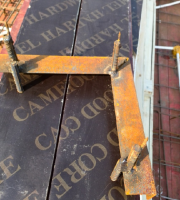(2) Hydration reaction of cement.
Therefore, for concrete roads constructed in summer, certain prevention measures must be taken, especially in concrete mixing, transportation, pouring and maintenance, and some special construction technical schemes must be applied to ensure the construction quality of concrete and make the quality meet the relevant construction specifications and design requirements.
1 causes of concrete road cracks 1.1 internal causes.
2 prevention and control measures for construction cracks of concrete roads in summer 2.1 select proper maintenance strategies and select maintenance methods as soon as possible.
Increasing the relative humidity of the air can comprehensively make the external water of the concrete not evaporate so quickly.
(4) No reasonable concrete curing measures are taken.
③ The phenomenon of “false setting” and too early setting makes cracks occur in early stage.
When mixing, vibrating, setting and hardening are carried out, cement and water can undergo hydration reaction.
On the basis of timely curing as much as possible, make the concrete exterior have more water, which can comprehensively avoid evaporation, reduce shrinkage, and ensure that the external hydration of concrete can be carried out in an orderly manner.
The water cement ratio can act on the strength of concrete quickly, and can also cause dry shrinkage cracks.
(3) The concrete mix proportion is uneven or there is no sufficient mixing time.
When there is more water, the shrinkage of concrete will be greater; With a large amount of cement, the plasticity can be greatly deformed.
Relevant research shows that when cement paste is constructed from cement paste in cement concrete, only 3% volume deformation occurs in cement paste, which can cause 13Mpa tensile stress on the interface between cement paste and aggregate.
(1) The cement concrete aggregate structure is layered.
(3) Dry shrinkage reaction occurs in cement concrete.
However, during the curing, there shall be no pollution and damage to the formed concrete.
Therefore, the newly poured concrete works tend to dry quickly, set faster, reduce the strength, and cause cracks, which will threaten the quality of the concrete structure.
In this process, the concrete strength is low due to obvious dry and wet deformation, chemical shrinkage and temperature deformation, and concrete cracks are easy to occur.
The key significance of curing is to make the concrete realize the whole process of hardening under the appropriate temperature and humidity conditions and improve the strength of concrete.
There is a lot of mud content in the aggregate, and there are many particles forming the mud film outside the aggregate, which can reduce the cementation between the aggregate and cement and improve the thinner position in the concrete.
1.2 external factors.
(2) Influence of seam cutting process.
When the concrete is set and hardened, its internal tensile strength is not very high.
However, the joint cutting process can only be carried out when the concrete achieves an appropriate strength (about 5MPa ~ 10MPa).
On the contrary, the joint mouth belongs to uneven rough edges.
Once the concrete body is not restricted by any factors, the expansion and contraction deformation can occur randomly.
Water is an essential substance for hydration reaction, and other substances can be evaporated, causing concrete to dry shrinkage deformation.
For the newly poured concrete with a series of curing, the curing measures shall be taken after the external shaping of the concrete and the external water film has not disappeared.
Therefore, it is necessary to select a proper curing strategy and the best curing period.
The high temperature in summer makes the water more easily evaporated.
However, the shrinkage amount in this link cannot be underestimated.
① Due to the theory of thermal expansion and cold contraction, the concrete poured during the day and in the middle of the night with very high temperature will certainly have volume shrinkage, that is, temperature deformation, at the lowest temperature in the next morning.
In the upwind direction and around the newly poured concrete, it is one of the appropriate methods to improve the relative humidity of the air by spraying water mist, which is not difficult to carry out and the capital investment is not high..
The proportion of water in cement concrete accounts for 15% ~ 20% of the total weight of cement.
② In summer, under the influence of sun exposure or dry hot wind, the temperature of sand and stone can reach the range of 60 to 70 ℃, and the temperature of mixed concrete can reach the high temperature of about 40 ℃.
If the batching is not accurate and there is no certain mixing, the concrete with discordant strength change can be produced, so that the part with weak strength has dense stress and causes cracks in the concrete road.
In the process of pouring and tamping cement concrete, certain delamination can occur.
Because the tensile stress produced by cold shrinkage and dry shrinkage needs to exceed the tensile strength in this case as much as possible, there are cracks inside and outside the concrete.
If the curing is not in place, the concrete can be “burned”, and the water outside the concrete will be evaporated in the shortest time, causing dry shrinkage cracks.
Because the concrete can be layered when it is constructed into a stacked structure, such delamination can make the concrete show greater strength from the outside to the inside.
The curing of cement concrete can effectively guarantee the quality of concrete.
(1) Temperature change.
Generally speaking, only when the cement concrete block is hardened and does not shrink, the crack can be prevented comprehensively by implementing the joint cutting treatment.
In other words, the external tensile capacity is not high, so the concrete cracks occur.
When this reaction is carried out, the concrete can undergo the second temperature rise and temperature drop, so the volume of concrete can undergo repeated secondary expansion and contraction deformation.
When the concrete with high temperature in the past is mixed and paved, it will be affected by the solar radiation, and the temperature will rise sharply, causing the appearance of “false setting” or premature setting, thus causing cracks in the concrete road.
2.2 increase the relative humidity of the air.




